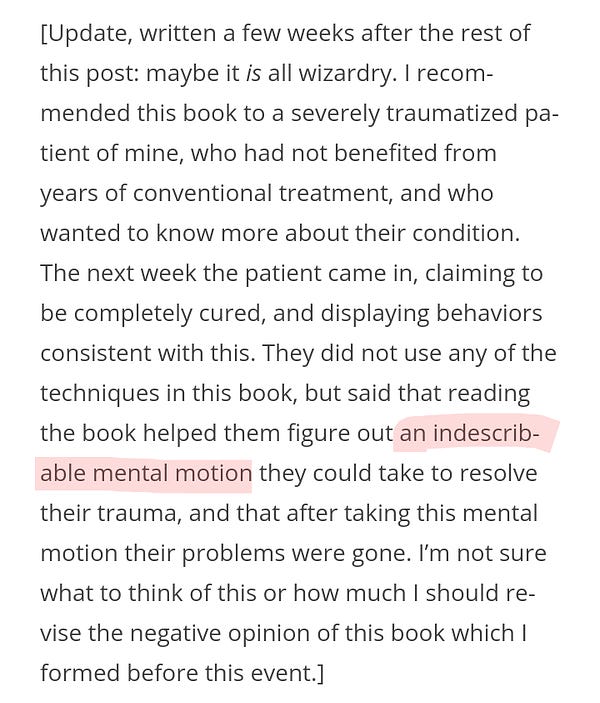You can solve your psychological problems by rejecting them. And if you tried to reject them and it didn’t work — well, get better at rejecting! Reject your past attempts at rejecting and try rejecting in a new way. Crucially, reject your past layers of cope.
Rejecting is a skill that you can develop, and by the way I’m selling you my 12 step course at rejecting things for only $16.99 per month. Please leave your email in the substack subscription box to be the first to learn when I release it.
There are multiple brands of Acceptance™ in the market of ideas. Some come from psychotherapy, some from Buddhists, some from pop-culture. Acceptance is often a wrong frame (but not always!). Applied incorrectly it may result in losing your ambition, confusion and self-gaslighting.
Rejecting things is dangerous. It’ll make you dangerous. You may piss off people. You may ruin your relationships. You may quit your job and travel the world. You may attempt to implement your ideas and fail (or even worse — succeed!).
That’s why people around you don’t suggest it. It’s safer to advocate for acceptance. Give a wrong piece of advice to someone, and they may blame you when they misapply it.
Society around you wants things from you. They want you to be a responsible and competent adult just like them. A good friend, a good partner, a good employee. A good buddhist or a good client.
A good NPC. They expect you to behave in a certain way. Worse, they expect you to compromise: give them something just so you comply with their expectations.
Me, on the other hand? I take no responsibility whatsoever. I fucked up applying my own advice, but I often succeeded too. I’m offering you a high-variance strat assuming you’ll be smarter than me in applying it sensibly. I’m an anon schizo poster, and I want to bring more anon schizo posters online exploring the outskirts of consensus reality.
Wielding double-edged swords is a useful skill in contemporary society. Are you an NPC or a main character?
What is even acceptance
Acceptance does not fully make sense to me. People advocating for acceptance point to a set of useful mental motions, sure. But there is no agreed-upon definition of acceptance. And if you pay attention you’ll notice that different people mean different things by acceptance.
Here is one of the ways I think about the mind. The mind is a configuration of beliefs. Some configurations feel better than others. Symmetrical and simple ideas feel the best.
The mind is constantly moving through the space of possible configurations. There are practices that help the mind move through the mindspace faster (like meditation) and drugs (like psychedelics).
Some movements from one configuration to another are called acceptance. But you might as well call them “rejecting”: abandoning an old configuration in favor of a new one.
Reject configurations that are not fun. Reconceptualize and refine your understanding. Find a way to shave off unnecessary details.
Inability to accept things
What does ‘inability to accept things’ look like? Negative emotions: anger, sadness, bitterness. Dwelling on old meanings. Getting stuck. It feels like someone threw a wrench into your world model. There is a mental knot that prevents the energy from flowing freely.
Getting a wrench out. Untying a mental knot. Dissipating stress. Smoothing out the world model. Unblocking yourself. Realigning the mind. Updating and moving on. Getting in touch with yourself. Merging several different parts of your mind together. Recalibrating your probabilistic machinery. Reshaping your mind. Gaining mental flexibility. These are mental motions that I like and endorse.
Every single one implies having a source and a target mental configuration. None necessarily imply getting closer to ‘reality’ or accepting ‘things’. It’s a good idea to venture deep in the magical forest and bring back what you find there.
It’s always sideways transformation
When moving on from a difficult situation you are always doing an indescribable sideways-through-the-4th-dimension let-go-the-old-meanings-find-a-new-way-to-look-at-things’ transformation.


To move on is to solve a puzzle. That’s why advocating for acceptance as a solution is oversimplifying things. When a puzzle is solved, most of the original pieces are gone, there are some new pieces from elsewhere, and it looks completely different.
Some initial mental motions can be reasonably described as acceptance. For example, accepting parts of yourself is a good idea. I am a big proponent of eating your shadow and mental frameworks like IFS.
Rejecting things by getting stuck is something that happens but better avoided. Getting stuck, resigning to circumstances and calling this acceptance is also better avoided.
Reject things optimistically and skillfully

Repeated mistakes and failures can make you depressed or even cynical. It’s easy to fall into such a mindset — I’ve fallen into it many times. Optimism is a scary and radical act. Believing in yourself can be frightening.
Start a company. Start a movement. Start a community. Run for the office.
Make friends. Find a scene. Learn a skill. Write a post, make a twitter thread, put your code on github, make a personal website.
You don’t have to accept things as they are.




